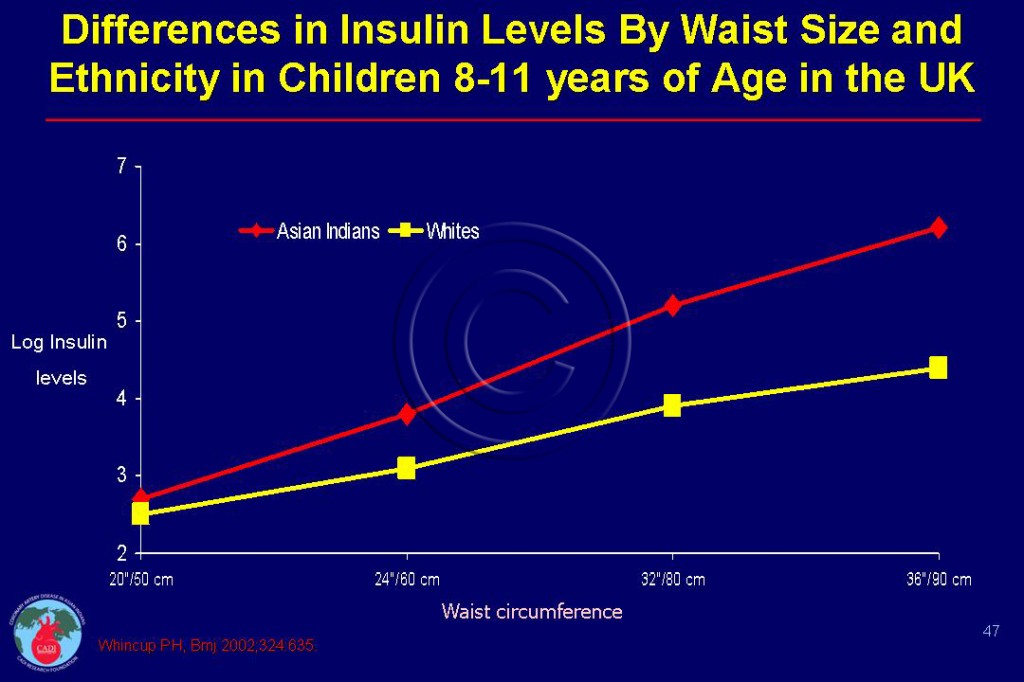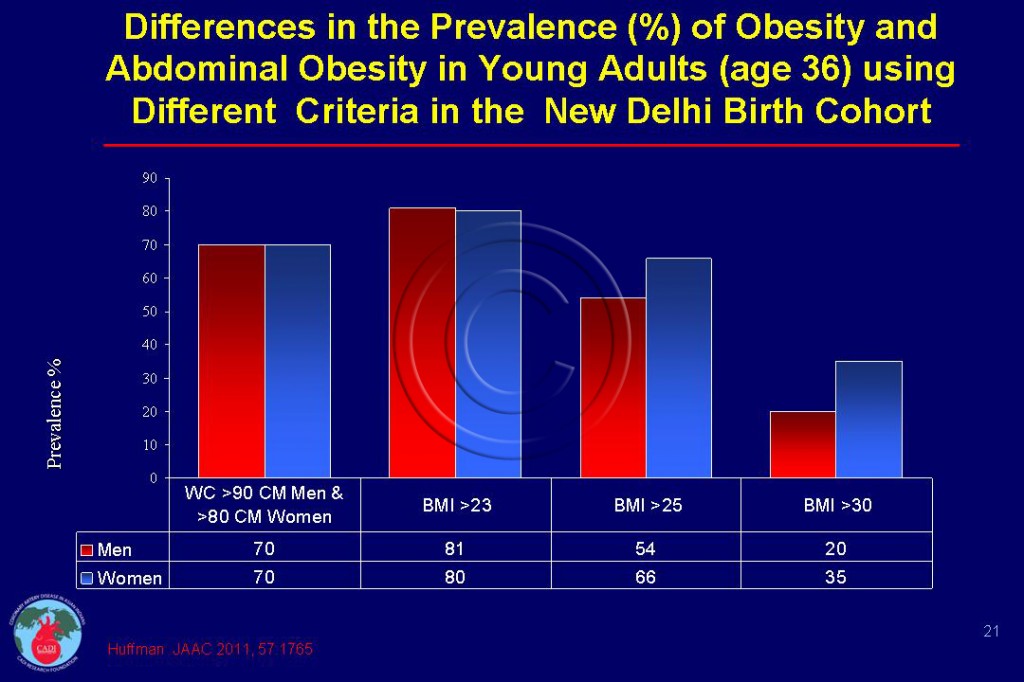Abdominal Obesity among Asian Indians
- High prevalence of abdominal obesity is a characteristic feature of Asian Indians and all South Asians. Furthermore, abdominal obesity can occur even in the absence of elevated body mass Index (BMI). Unlike other populations abdominal obesity has been reported even at BMI levels <20kg/m2 and is seen even at a young age.1-8
- At any given BMI or waist circumference, compared to Europids, South Asians have more abdominal visceral fat, higher degree of insulin resistance, hyperinsulinemia, hypertension and diabetes all of which are implicated in the pathogenesis of premature coronary artery disease (CAD).6, 9, 10
- Such abnormalities are evident even in children as young as 8-11 years of age who have higher insulin levels at a waist circumference (WC) of 80 cm compared to Europid children with a WC of >90 cm.6, 11 (Figure 047)11 . In Indian children with a WC of 80cm have higher insulin levels, (a predictor of impending diabetes) than white children with WC of 90cm.11This underscores the rationale for lower cutpoints for WC for Indians.
- At a similar body fat percentage South Asian men in the US have 10 cm lower waist circumference than Europids.12
- In recognition of the heightened risk at lower WC in Asian populations and to harmonize the definition of metabolic syndrome throughout the world, all major International organizations have jointly published a consensus document with ethnic and gender specific criteria for WC in 2009, which have also been endorsed by Indo-US Health summit and Indian Consensus group (see Abdominal Obesity Criteria).13 14
- The WC cut point for the diagnosis of abdominal obesity is >90cm for Asian Indian men and as opposed to >102cm for Europid men. The respective cut points are >80 cm for Asian Indian women and 88cm for Europid women. These values are about 8-12 cm lower than that recommended for Europids, and underscore the need for early institution of weight management programs.15 Despite endorsement by several expert bodies, these lower cutpoints for Asian Indians remain largely unrecognized by the medical community and the general public alike in both the US and India.13, 14, 16
- In a study of Asian Indians with a mean age of 22 years living in the US, the mean WC was 87 cm for men and 79 cm for women.17 These values at this young age are alarmingly close to the Asian Indian cutpoints and portend an epidemic of metabolic syndrome and diabetes in the second and third generations of Asian Indians in the US.18
- The differences in the prevalence of obesity and abdominal obesity by various criteria in the New Delhi birth cohort at age 36 are shown in the Figure 021. Abdominal obesity was found in 70% of men and women but BMI >30 was found only 20 % of men and 35% of women and underscore the magnitude of underestimation of metabolic risk among Asian Indians by just focusing on BMI.19
- Using the standard (Europid) waist circumference (> 102/88), the prevalence of abdominal obesity among Asian Indians was only 22% in the UK but increased to 44% when WHR criteria was used and decreased to 12% when BMI >30 was used.20, 21
Sources
1. WHO/IASO/ITO. Asia Pacific Perspective:Redefing obesity and its treatment World Health Organization, Western Pacific Region;2000.
2. Misra A., Khurana L. Obesity-related non-communicable diseases: South Asians vs White Caucasians. International journal of obesity (2005). Jul 20 2010.
3.Misra A., Sharma R, Pandey RM, Khanna N. Adverse profile of dietary nutrients, anthropometry and lipids in urban slum dwellers of northern India. European journal of clinical nutrition. Sep 2001;55(9):727-734.
4. Misra A, Pandey RM, Devi JR, Sharma R, Vikram NK, Khanna N. High prevalence of diabetes, obesity and dyslipidaemia in urban slum population in northern India. Int J Obes Relat Metab Disord. Nov 2001;25(11):1722-1729.
5. Misra A., Athiko D, Sharma R, Pandey RM, Khanna N. Non-obese hyperlipidemic Asian northern Indian males have adverse anthropometric profile. Nutr Metab Cardiovasc Dis. Aug 2002;12(4):178-183.
6. McKeigue PM, Shah B, Marmot MG. Relation of central obesity and insulin resistance with high diabetes prevalence and cardiovascular risk in South Asians. Lancet. 1991;337(8738):382-386.
7. Misra A., Vikram NK. Clinical and pathophysiological consequences of abdominal adiposity and abdominal adipose tissue depots. Nutrition (Burbank, Los Angeles County, Calif. May 2003;19(5):457-466.
8. Hughes K, Aw TC, Kuperan P, Choo M. Central obesity, insulin resistance, syndrome X, lipoprotein(a), and cardiovascular risk in Indians, Malays, and Chinese in Singapore. J Epidemiol Community Health. 1997;51(4):394-399.
9. Raji A, Seely EW, Arky RA, Simonson DC. Body fat distribution and insulin resistance in healthy Asian Indians and Caucasians. The Journal of clinical endocrinology and metabolism. 2001;86(11):5366-5371.
10. Hodge AM, Dowse GK, Collins VR, et al. Abdominal fat distribution and insulin levels only partially explain adverse cardiovascular risk profile in Asian Indians. J Cardiovasc Risk. 1996;3(3):263-270.
11. Whincup PH, Gilg JA, Papacosta O, et al. Early evidence of ethnic differences in cardiovascular risk: cross sectional comparison of British South Asian and white children. Bmj. 2002;324(7338):635.
12. Chandalia M, Lin P, Seenivasan T, et al. Insulin resistance and body fat distribution in South Asian men compared to Caucasian men. PLoS ONE. 2007;2(8):e812.
13. Alberti KG, Eckel RH, Grundy SM, et al. Harmonizing the metabolic syndrome: a joint interim statement of the International Diabetes Federation Task Force on Epidemiology and Prevention; National Heart, Lung, and Blood Institute; American Heart Association; World Heart Federation; International Atherosclerosis Society; and international association for the Study of Obesity. Circulation. Oct 20 2009;120(16):1640-1645.
14. Enas EA, Singh V, Gupta R, Patel R, et al. Recommendations of the Second Indo-US Health Summit for the prevention and control of cardiovascular disease among Asian Indians. Indian heart journal. 2009;61:265-74.
15. Lemieux I, Pascot A, Couillard C, et al. Hypertriglyceridemic waist: A marker of the atherogenic metabolic triad (hyperinsulinemia; hyperapolipoprotein B; small, dense LDL) in men? Circulation. 2000;102(2):179-184.
16. Misra A , Chowbey P, Makkar B. Consensus statement for diagnosis of obesity, abdominal obesity, and metabolic syndrome, for Asian Indians and recomendations for physical activity, medical and surgical management. JAPI. 2009;57:163-170.
17. Shah T, Jonnalagadda SS, Kicklighter JR, Diwan S, Hopkins BL. Prevalence of metabolic syndrome risk factors among young adult Asian Indians. Journal of immigrant health. Apr 2005;7(2):117-126.
18. Enas EA, Mohan V, Deepa M, Farooq S, Pazhoor S, Chennikkara H. The metabolic syndrome and dyslipidemia among Asian Indians: a population with high rates of diabetes and premature coronary artery disease. Journal of the cardiometabolic syndrome. Fall 2007;2(4):267-275.
19. Huffman M D, Prabhakaran D, Osmond C, et al. Incidence of cardiovascular risk factors in an Indian urban cohort results from the new delhi birth cohort. J Am Coll Cardiol. Apr 26 2011;57(17):1765-1774.
20. Tillin T, Forouhi N, Johnston DG, McKeigue PM, Chaturvedi N, Godsland IF. Metabolic syndrome and coronary heart disease in South Asians, African-Caribbeans and white Europeans: a UK population-based cross-sectional study. Diabetologia. Apr 2005;48(4):649-656.
21. www.heartstats.org. CHD Statistics. Mortality. 2011. Accessed July 15, 2011.



